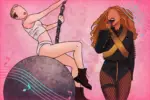“Art is therapy just like this view. Art is protected as freedom of speech. Art inspires and simplifies the world. Art is not a proxy for any ill or harm. Any suggestion otherwise about my art is false and mal-intended.” This was Kanye West’s response to the backlash he received for the music video to his song “Eazy,” featuring The Game. The clay animation video depicts West abducting actor and comedian Pete Davidson and killing him by planting roses on his head. Davidson is dating West’s ex-wife, Kim Kardashian, and West has publicly expressed his resentment toward him online, which culminated in the portrayal of Pete’s death in the video.
Though West adamantly denies any intention to harm Davidson, one line in his song says otherwise, with West rapping that he wants to “… beat Pete Davidson’s ass.” At the end of the video, an ominous text appears on-screen that reads “Everyone lived happily ever after,” flashing to another text that reads “Except Skete,” referring to West’s nickname for Davidson; the name Skete is then scribbled out and replaced with “you know who” to insinuate that West doesn’t even want to mention the comedian by name. This is quickly followed by a final onscreen text that reads “Jk he’s fine” as if West is taking back everything he said. Regardless, many found the music video to be strange and disturbing, expressing their concerns on social media and prompting West to make a statement.
Despite the backlash, West claims that his video wasn’t meant to harm anyone and those who believe it did misunderstand the message. Though West’s statement is right about the inspirational power of art, in this case, his treatment of Davidson seems more like bullying and harassment than artistic freedom, especially considering the events that led up to the creation of the video. His intentions, even if he didn’t physically do anything to Pete, are clear and can be threatening. This isn’t the first time West’s artistic freedom has led to controversy, as he has a habit of doing things without people’s permission or doing what he wants under the guise of creative expression.
Take, for example, West’s artistic decision to create a music video for his 2017 song “Famous.” Inspired by artist Vincent Desiderio’s painting “Sleep,” the video features several celebrities and public figures such as Donald Trump, Taylor Swift, Bill Cosby, Rihanna and Caitlyn Jenner among others as nude wax figures sleeping side by side. The video polarized the internet and sent social media into a frenzy since the wax figures appear to be real, which prompted representatives from some of those featured to make it clear they were not involved.
West was well aware of how provocative the music video was, saying the following day in a now-deleted tweet, “Can somebody sue me already? #I’llwait.” West also didn’t ask for permission to use the people’s likenesses in his video and did not tell the people featured what he would do, which drew a lot of criticism online. Not only did he use their likeness without their permission, but they were also naked, which violates their privacy. Unfortunately, West’s questionable creative choices wouldn’t stop there.
West also used a picture of the late Whitney Houston’s bathroom as cover artwork for a 2018 rap album he was producing for rapper and label mate Pusha T. The bathroom was littered with cigarettes, lighters and drug paraphernalia, evidence of Houston’s struggle with addiction. Whitney’s ex-husband, Bobby Brown, said what West did was “in really bad taste” and Houston’s family was also shocked and disgusted over his actions, unsure of why he would even want to use the image in the first place. They weren’t made aware of the album cover until the project was released, stating that the use of the sensitive photo made them feel sick.
West’s tendency to take action without permission crosses the line, whether it’s artistic freedom or not, and it comes across as insensitive rather than creative. The only reason most people watched the “Famous” music video or even heard about it, was because of how provocative the video was — it thus calls into question whether West did it for the sake of art or attention-seeking. And though his intentions behind using the picture of Whitney Houston’s home aren’t entirely clear (though fans have speculated), the controversial image of the late singer’s drug-strewn bathroom brought attention to the album he produced.
Kanye West’s questionable motives can also be seen in the artwork of a scrapped 2018 album titled “Love Everyone.” The album cover had a mugshot photo of Jan Adams, the doctor who performed surgery on West’s late mother, Donda West, who unfortunately passed away due to complications following the procedure in 2007. In the aftermath, Dr. Jan Adams garnered negative media attention because of people associating his practice with the death of Donda West.
Regardless, West felt it was time for him to move on from the situation and wanted the message of the album cover to be about forgiveness and positivity. However, Dr. Adams responded to West’s artistic choice to use his mugshot photo in an open letter, expressing that he felt misrepresented by the media following his mother’s death and cautiously questioning the sincerity of the artist’s actions, saying:
“I am impressed that you want to ‘forgive and stop hating’. That’s impressive… I don’t want to seem ungrateful… I just think that if in fact this conversion to love is genuine on your part… then it’s inappropriate to drag the negativity of the past with it.”
By using his picture, as Adams says, West reinforces the idea that the doctor was directly responsible for his mother’s death and brings the negativity of the past into the positive headspace West is attempting to embrace. As tragic as Donda West’s death is, Dr. Adams’ concerns that West’s artistic choice to feature him on the cover sends the wrong message are entirely valid. West ended up scrapping the entire project altogether and released another project in its place called “Ye” (2018).
West’s “Eazy” music video appears to combine questionable intentions and personal feuds. The events leading up to the video’s creation make it hard to believe West meant no harm. West repeatedly trolled Davidson online, posted memes about him and told his fans to harass the actor if they saw him in public. Besides this, the “Eazy” video depicts West abducting and killing Pete, accompanied by lyrics describing his desire to assault Davidson, and this doesn’t help his case. It’s simply bullying, which isn’t inspirational or uplifting and doesn’t embody artistic freedom, as West highlights in his statement.
While West is a controversial figure, he has cemented himself as a musical icon, influencing many hip-hop artists today like Tyler, the Creator, J.Cole, Drake and Travis Scott, just to name a few. His creativity knows no limit and he is a true visionary that seeks to share his artistic passion with his fans and the world. West can create beautiful work. His music video for his 2010 song “Stronger” was heavily influenced by the Japanese animated film “Akira” and he recreates scenes in his music video, paying homage to his favorite movie. West also created and directed a musical short film called “Runaway,” an introspective story about a relationship between a man and a phoenix-woman hybrid, which fans have described as a masterpiece. This goes to show his innovation at work.
However, some of his creative choices seem more like stunts and come across as insensitive rather than creative. Though West is right about artistic freedom and breaking boundaries, if pushing the limits involves hurting, harassing or bringing negativity to a situation rather than inspiring others, it ruins the impact. It’s unfortunate that the “Eazy” video is marked by West’s personal feud with Davidson. The visuals for the video, which combine clay animation and live-action scenes, are original and innovative. The bleak landscape, dingy atmosphere, the eerie vibe, and claymation models would’ve been appreciated more had it not been marred by West’s vendetta against the actor.
Kanye West can make creative choices and use artistic freedom to express himself in ways that don’t bring negativity or harm to others, and his musical discography has many examples we can pull from. However, it’s clear from the music video for “Eazy” that he intended harm given the situation. Harassing and bullying his ex-wife’s current partner is unnecessary and wrong. We can only hope that Ye gets the help he needs, and in his own words to Dr. Adams, “forgive and stop hating,” so that he can continue to share his creative vision with his fans and world without controversy.
















